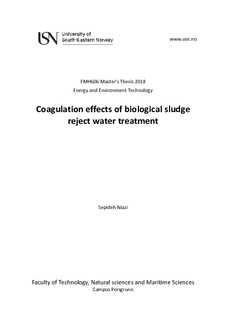Coagulation effects of biological sludge reject water treatment
Master thesis
Permanent lenke
http://hdl.handle.net/11250/2567165Utgivelsesdato
2018Metadata
Vis full innførselSamlinger
Sammendrag
This thesis is study of methods for improving the coagulation process of municipal wastewater in Norway, carried out at the Knarrdalstrand wastewater treatment plant in Porsgrunn. In the study two main issue were considered as the aim of the thesis: I) replacing iron with calcium compounds as coagulant to provide a calcium-phosphate rich sludge for fertilizer purposes II) investigating effects of biological reject water treatment on coagulation efficiency when treated reject water is mixed with raw wastewater.
I) Conventionally wastewater treatment at the Knarrdalstrand plant uses ferric chloride as the coagulant. However, the phosphate precipitates as iron phosphate which is so strongly bound that the phosphate is not accessible nutrient for plant uptake. Hence calcium hydroxide was tested as an alternative coagulant to provide a phosphate rich sludge which is easier to recover phosphorus as fertilizer. Proper dosage and fast mixing time for both coagulants were determined through several repeated jar tests and the effects of the two coagulants were evaluated on coagulation of the treatment plant wastewater. Three and 15 seconds for fast stirring time and dosages of 2 mL/L and 800 mg/L coagulant were applied as the initial condition for ferric chloride and calcium hydroxide, respectively. The study shows that calcium hydroxide exhibited less sludge volume with higher solids content and faster settling velocity. The average sludge volume index (SVI) value of calcium hydroxide coagulated sludge was 46 ±5 mL/g which was around six times less than the average SVI of ferric chloride coagulation on the same wastewater. The results also show that the removal of organic matter (i.e. COD) and phosphorus were similar for the two coagulants. The reduction of COD and phosphorus were 89 ±9 % and 95 ±1 %, respectively, for calcium hydroxide while these values for ferric chloride were 76 ±15 % and 93 ±3 %, respectively. A positive effect on biogas methane potential (BMP) of calcium hydroxide compared with ferric chloride coagulant was measured and explained by enhanced hydrolysis.
II) The reject water contains high amounts of organic and inorganic compounds that causes process disturbance on the main coagulation process when it is returned to the main inlet. Two pilot scale biofilm reactors (MBBR) were employed to treat reject water biologically to test if such treatment can reduce the process disturbance and enhance coagulations efficiency. Treated and untreated reject water was mixed with raw wastewater the in ratio calculated for typical full scale plant and coagulation performance was investigated in several repeated Jar-tests with both ferric chloride and calcium hydroxide as coagulants. The results revealed that, when wastewater COD concentration was in the range of 140 to 350 mg/L, treating reject water gave better COD removal using both coagulants, confirming the advantage of biological reject water treatment. E.g. coagulation reduced the wastewater COD to 39 ±11 mg/L when the reject water was biologically treated while coagulation of untreated reject water decreased the COD to 58 ±5 mg/L. In both cases the same amount of ferric chloride coagulant dosage was applied as in the full scale plant. Biological reject water treatment did not show any statistically significant effect on turbidity and phosphorus removal through coagulation. Moreover, The SVI of the coagulated sludge was approximately the same for the treated and untreated reject water cases.
